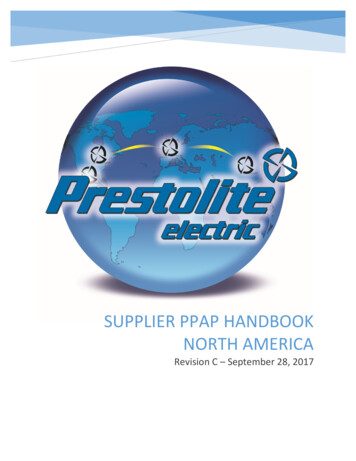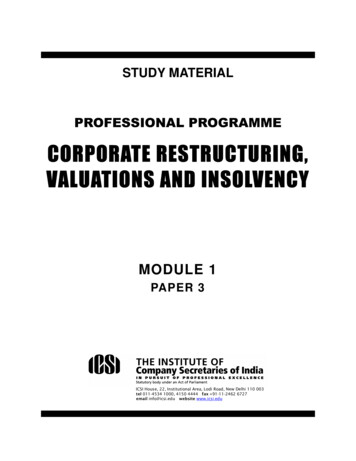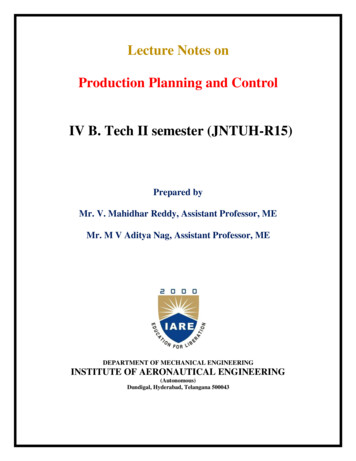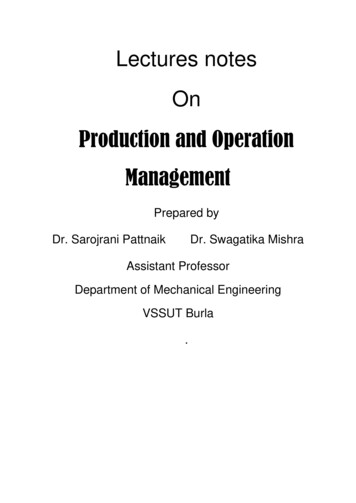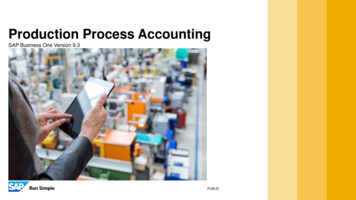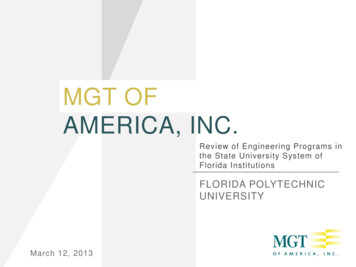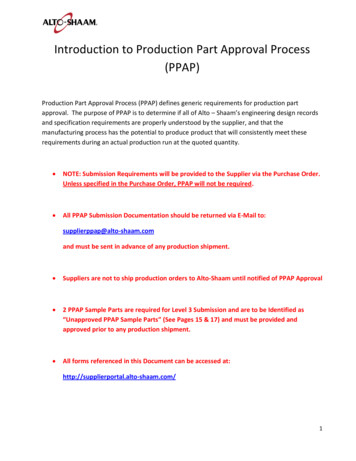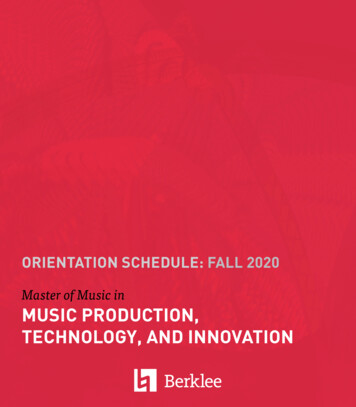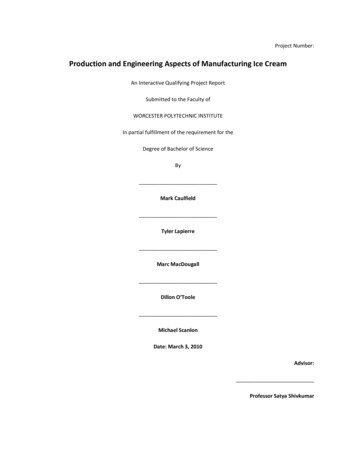
Transcription
Project Number:Production and Engineering Aspects of Manufacturing Ice CreamAn Interactive Qualifying Project ReportSubmitted to the Faculty ofWORCESTER POLYTECHNIC INSTITUTEIn partial fulfillment of the requirement for theDegree of Bachelor of ScienceByMark CaulfieldTyler LapierreMarc MacDougallDillon O’TooleMichael ScanlonDate: March 3, 2010Advisor:Professor Satya Shivkumar
AbstractThe purpose of this study is to develop an informative website that details the production of icecream. The types of ingredients and the steps associated with the making of homemade andcommercial ice cream are outlined. The effects of the processing steps used to make the icecream on the mechanical properties have been studied. It is anticipated that the web site willimprove the public understanding of the engineering principles necessary to make this uniquetreat.2
AcknowledgementsNona’s HomemadeThe Melt Review group would like to acknowledge Nona’s Homemade, in Hingham, MA, for theirpatience and willingness to help our cause. Without the video and the hands on guidance from Krissyand Tom our group would not have had the practical experience needed to complete this project. Wewould like to send our sincerest thanks to the Donahue’s at Nona’s Homemade where we have beenconstantly reminded to “Eat Your Dessert First” – Kristin Donahue.Biology and Biotechnology DepartmentThe Melt Review group would like to thank Abbie White and the rest of the WPI Biology andBiotechnology Department. Everyone was very helpful and courteous as we continued to needliquid nitrogen to complete our project. Our group really appreciates all patience that you hadwith us.3
Table of ContentsChapter 1: Introduction . .5Chapter 2: Objectives . . .6Chapter 3: Background . . 73.1 History of Ice Cream . .73.2 Ice Cream on the Internet 7Chapter 4: Methodologies . 94.1 Website .94.2 Videos . . 124.3 Parlor Visits . .144.4 Business Plan . . 154.5 Compression Test . . .16Chapter 5: Compression Test Results . .18Chapter 6: Conclusion . .20Chapter 7: References .22Chapter 8: Appendices .258.1 Appendix A .258.2 Appendix B . . .348.3 Appendix C .388.4 Appendix D .444
Chapter 1: IntroductionSince 2007, when the economy went into a recession, most industries have been in a decline.However, that is not the case with the ice cream industry. It has been nearly “recession proof”and has even grown by about 2 percent each year. In 2009 alone, there was 1.52 billion gallonsof ice cream produced in the United States, which represented about 26.2 percent of the entirefrozen dairy product market. In the United States, more than 90 percent of householdsconsumed ice cream in 2009 (WC 14). So this begs the question: What exactly is ice cream? Andwhat makes it so delicious?There are several different types of frozen treats. There is dairy ice cream, non-dairy ice cream,gelato, frozen yogurt, milk ice, sorbet, sherbet, water ice, and fruit ice. This study focuses ondairy ice cream. According to “The Science of Ice Cream”, by C. Clarke, dairy ice cream is afrozen, aerated mixture of dairy ingredients, sugars, and flavors (WC 2 p.1). This is the productthat most people are referring to when they speak about ice cream. There are several differentmethods and ingredients used to produce ice cream. These different methods and ingredientsare what distinguish ice creams from each other and make some very unique.This study aims to create an informative website detailing the production of ice cream. Theproduction methods that are studied include continuous freezing (commercial), batch freezing(homemade), bag method (individual), pot freezing method (individual), and liquid nitrogenmethod (individual). The website includes instructional videos detailing the process to produceice cream through the individual methods. Nona’s Homemade, based out of Hingham MA,helped create a video that outlines the process to make their delicious ice cream. Another goalfor the website is to explain the structure of the ice cream in a unique way to help peopleunderstand each ingredient’s purpose in the structure. Additionally, an experiment wasconducted on several different processes of making ice cream. The purpose of the experimentwas to show scientific and structural differences between the production methods.5
Chapter 2: ObjectivesThis project aims to accomplish the following objectives:1. Create a unique website detailing the industrial processes of producing ice creama. Do It Yourself Videosb. Commercial versus Homemade Ice Cream Productionc. Interactive Timeline of the history of ice creamd. Interactive map of local homemade ice cream parlorse. Provide FDA guidelines for different types of ice creamf. Provide nutritional facts for ice creamg. Create an analogy between the structure of ice cream and a building structure2. Visit homemade ice cream parlors in Massachusettsa. Create and establish a working relationship with homemade parlor ownersb. Use questionnaire to establish a basis for popular and unique ice creams3. Create a business plan that will provide us with a great foundation for the ongoingmaintenance of the website.6
Chapter 3: Background3.1 History of Ice CreamAlthough the actual history of ice cream is not well documented, the following account appearsto be well known and has been passed down through generations as a wide spread belief.The history of ice cream begins in China. About 3,000 years ago the Chinese the invented thefirst type of ice cream which is now referred to as snow ice cream. However, what they reallyinvented was closer to water ice, frozen sugar syrup with flavor and color, or fruit ice, similar towater ice, but made with real fruit juice (WC 2 p. 1). Ice cream did not evolve into what it istoday until it was brought to Europe by Marco Polo in 1295. The recipe for ice cream was givenas a gift to royalty throughout Europe. The recipe changed as it went from country to country.Therefore, it is impossible to determine which country is responsible for the modern recipe forice cream. Since the discovery of the modern recipe for ice cream, there have been advances inthe production of ice cream and the creation of hundreds, if not thousands, of different flavors.3.2 Ice Cream on the InternetPart of the study was to create a website that was unique and helpful. Therefore, research wasperformed on the existing websites regarding ice cream. Two things were evident whileanalyzing these other sites; first, there were many websites dedicated to ice cream. Second, allthe information on the internet appeared to be disorganized or scattered. Most of the websitesfocus on one aspect of ice cream, and did not provide all the information sought by viewers.This wastes time and causes frustration for viewers. Along with information being scatteredover the internet, videos on how to make ice cream were not on any of these informativewebsites. Most of the videos were only on YouTube. This shows the necessity for a website thatcompiles all the data in one place.7
Another noticeable trend was the lack of creativity. This means that all the websites were blandand only contained text. A bland website may be ignored or skimmed, which could lead thereader to miss important information. The website for this project has been created to standout from other ice cream websites and the presentation will be central for the website.8
Methodologies4.1 WebsiteGoogle Sites was used to host “The Melt Review”. Google offered a very speedy and user friendlywebsite creator. Also, Google has many web friendly applications that are in sync. On top of thesebenefits, the main reason Google Sites was chosen as the host was because of their zero dollar cost.Naming the site was difficult to agree on. After several attempts choosing a host name the idea settledupon was a forum style site in which a homemade ice cream parlor would be visited each week and areview would be written. As a result, “The Melt Review” was chosen as the name. After a few moreweeks of work, the site took on a new style and weaned away from the original idea, however the namestuck.9
The map on the website was created using Google maps. To insert a parlor onto the map it wasnecessary to search for the parlor on Google. If the parlor was available it could be added to theembedded map along with a picture and street view. These features are part of the Google Mapsprogram and are available for custom maps. If the parlor could not be found, the location was manuallyentered, thus creating information for that parlor.10
For the timeline on the website, timeglider.com was used. With a simple to use interface and nice sleeklook, it was a nice addition to the website. The timeline has bubbles that pop up for every new instancewith a picture and text explaining the instance.The videos on “The Melt Review” were uploaded for free using Youtube.com. YouTube was chosenbecause a member had already personally used it, and knew it was exactly what was needed. Thebiggest problem with any the videos was the Nona’s video. Due to the lengthy run time, YouTube wouldnot accept it. As a result, the video was split it into two halves then uploaded. Creating the make ityourself videos were quite easy; the end result was fun to watch and informative.The “Science!” page on the site has the engineering information for ice cream. The texturemeasurement tests were captured on video. Also included on this page were graphs and tables alongwith text to further explain the texture measurement tests.11
4.2 VideosA large part of the project was creating videos to place on the website. Videos were needed toadd a multimedia aspect to the website, which would improve the overall experience. Allfilming equipment was supplied by the WPI Academic Technology Center. The videos were firstuploaded to YouTube, and then embedded onto the website. They were then broken into twodifferent categories, the first on creating ice cream, and the second on ice cream in a differentcontext.The videos detailed different processes of creating ice cream from hand. Each video began withpre-measuring all the ingredients. The second step was to follow the recipes available in the12
“Do It Yourself” page of the website. Each video contains a gap in time during which the mixingof ingredients was performed. The videos ended with a shot of the created ice cream. Thissame basic framework was used for the Bag method, Pot Freezer method, and Liquid Nitrogenmethod.13
Another video was shot in Nona’s Homemade in Hingham, MA. The ice cream makingmachinery consisted of one batch freezer and two large walk in freezers. One freezer was setto a lower temperature for a quick freeze. A storage freezer was set at a higher temperature,allowing the ice cream to be workable when removed. The co-owner of the establishment wasinitially filmed creating a batch of ice cream. Afterward, a group member was filmed making abatch while being instructed by the co-owner. Filming ended with a quick interview in the frontof the store. Another video was the filming of an ice cream eating contest. The contest was atWPI and sponsored by Hershey’s.4.3 Parlor VisitsThe beginning of this project entailed finding parlors, and since most are family owned andoperated, many would not have their own websites or on-line addresses. After sifting throughthe hundreds of Google links and utilizing Google maps to help locate these parlors, it wasnecessary to expand the search to friends and family. In the end asking grandparents and elderrelatives proved more helpful than Google.14
After collecting this list of owners, phone numbers, and addresses, interview were arranged.This began completely wrong with an attempt to walk up to the owners without a prior phonecall. The first man believed this was an attempt to steal his family recipes and refused torespond. After that embarrassment it became a unanimous decision to call the owners beforeshowing up.During the summer it was tough to get the five man group together and between work anddriving distances it became impossible to interview parlor owners so most of the interviewingwas conducted by Mike Scanlon. The questionnaire was kept relatively short because theseowners were taking time out of their workday. The questionnaire consisted of fifteen questionscovering the owners background, the shops background, their most unique and commonrecipes, along with a couple manufacturing questions (Appendix C). The basic purpose of thequestionnaire is to get to know the owners better and help understand the products andservices they provide. After five in person interviews it was decided this approach was not thebest and not the most financially sound because it was too expensive to drive to these parlors.The list needed to be cut down to specific parlors. One parlor chosen was Nona's Homemadeout of Hingham Massachusetts, and they agreed to let the group film and make ice cream.4.4 Business PlanThe purpose of the business plan was to analyze what it would take to make the websiteprofitable. The first part of the business plan was an in depth description of what the websiteprovides for the public. This gives the investor a good idea of the purpose and benefits of thewebsite. The next part of the business plan is the marketing plan. The marketing plan gives adetailed explanation of how the group plans to sell advertising spots on the website. The nextpart of the business plan is the operations plan, which describes the physical necessitiesrequired to run the business. These parts of the business plan are straight forward and do notrequire extensive research in order to complete.15
The next part of the business plan is the financial plan. The financial plan contains multipleparts. The first part is a projection of sales. This includes projected revenue, variable costs, fixedcosts, contribution margin, and net income. There are multiple scenarios; one can view how thebusiness will do in different situations. The next part of the financial plan is a break-evenanalysis. The break-even analysis shows how many advertisements the website would need tosell in order to break-even. This business plan will provide a great foundation for the ongoingmaintenance of the website. See Appendix D to view the business plan.4.5 Texture Measurement TestsThe texture measurement tests were performed on different ice cream samples giving scientificdata to interpret. Vanilla ice cream was made in three different ways. A commercial brand ofvanilla was also tested as a control. To keep tests consistent the samples were frozen in thesame freezer for the same amount of time to eliminate discrepancies between the samples. Icecream was made using the three homemade processes posted on the website, under the “Do ItYourself” page. The three processes include the Bag method, Pot Freezer method, and LiquidNitrogen method. In order to get the ice cream in the shape needed for testing, the ice creamwas placed in aluminum cans with the top cut off. By placing the ice cream in the aluminumcans, it took the shape of the can and therefore gave a uniform shape for all the molds. Byusing this method for creating samples the cross sectional area was kept constant at 4.43in2. The ice cream was then cut using a band saw one at a time as they were needed fortesting. When the ice cream was not being tested it was kept in a freezer.Steps were taken to prevent damage to the testing apparatus. The most significant danger wasthe dripping of the liquid ice cream into the machine. This occurs because the ice cream isviscoelastic and when a force is applied the friction inside the ice cream increases; thus the heatincreases causing the ice cream to melt. To protect the machine an acrylic box was constructedand the top of the box was lined with saran wrap. This system helps keep the potentiallydamaging liquid out of the electronics inside the machine. Also the sides of the machine were16
coated with aluminum foil to help keep possible splatter out of the gears inside the uprightbeams. Once the machine had been properly prepared testing began.The testing apparatus is capable of recording a 0.01 Newton force at a 100 millisecond interval.This is useful information for detailing the connections between internal structure and tastetexture experienced by the consumer. The data found from these tests can be used to calculatevarious significant mechanical properties such as yield stress, strain, elastic modulus, andcollapsing force.17
Chapter 5: Texture Measurement Test ResultsFrom the texture measurement tests, results were compiled for each type of ice cream. Thefirst step in obtaining certain properties of the ice cream was to plot the data, time on the x axisand the load applied on the y axis. From this graph the collapsing force of the ice cream wasfound. The collapsing force is defined as the amount of force needed to compress all the airbubbles inside the ice cream. When looking at this graph, there is a clear plateau near thebeginning. The first points on this plateau, as well as the last point on this plateau, were usedin calculating the collapsing force. The collapsing force was calculated by finding the averageforce between these two points. The beginning of this graph shows the elastic deformation ofthe ice cream, which is the recoverable deformation. In contrast, the rise after the plateaurepresents the plastic deformation of the ice cream. This is the non-recoverable or permanentdeformation.The next property that was determined was the yield stress for each individual test. Tocalculate the yield stress, the collapsing force was divided by the cross sectional area of thesample. The reason it was calculated in this fashion was because stress is defined as loaddivided by area. The term yield stress is used because this is the point where elasticdeformation ends and plastic deformation begins.Another mechanical property found for each compression test was the Elastic Modulus (E). TheElastic Modulus of a specimen is the relationship between stress and strain in the elastic regionof the stress versus strain graph. The higher the Elastic Modulus, the more resilient thespecimen is. The elastic modulus was calculated for each test by dividing the yield stress by theyield strain; these values were used because this region is linear.Another interesting relationship was the time it took each sample to reach the collapsing force.To calculate this value the final point of the first plateau on the time versus load graph wastaken and then the time value where the load was first applied was subtracted. This value wasnot always zero because it took time for the testing apparatus to first apply a load to the icecream.18
To see the final calculations, including tables and graphs, view the “SCIENCE” page on thewebsite or Appendix A.19
Chapter 6: ConclusionsIce cream is a marvel of modern engineering and will continue to evolve as time goes on. Usingthe developing knowledge of structural engineering, and the ever growing demand for thisdelicious treat, companies have had to mass produce while keeping recipes traditional andincreasing profits. The ice crystal structure has been broken down, studied, and turned into ascience. Everything known about how ice freezes and how ingredients react with it has becomeformulated, graphed, maximized, and minimized, producing a product that not only has a longshelf life but tastes fresh out of the freezer. The matrix structure of ice cream is comparable toa tightly woven web containing everything needed to make ice cream. The fats, stabilizers,emulsifiers, sugars, and proteins are trapped inside the matrix. However, the most importantpart of the structure is the types of bonds formed between these molecules and how theybreak. In modern science bond breaking and forming is crucial; the types of bonds and howthey react determine what physical and mechanical properties the substance exhibits. For icecream, the scientists needed a substance that was structurally stable at low temperatures, butwould not be brittle. Although scientists and engineers have been working at this for decades,they will continue to do so for decades to come. Ice cream’s humble icy origins in themountains of China and now the modern day factory ice cream man has made and remadesimple fruit ice hundreds of times to reach what it is today.The project resulted in a few key findings. When a taste test was performed betweenhomemade ice cream from Nona’s and commercially made ice cream, the homemade waswidely preferred. When texture tests were performed to the homemade ice cream samples,they were nearly twice as strong as the commercial brand. This difference in strength can beattributed to the inability to aerate the ice cream properly as it froze. As a result, thehomemade samples had fewer air bubbles. The lack of air bubbles created a brittle and icytexture, unlike the smooth and creamy texture of the commercial brand.Throughout the project, the group learned not only about ice cream, but group dynamics andweb design. The group was able to not only learn about mechanical properties of ice cream,20
but also the opinions and preferences of individuals regarding ice cream. For scientific data,homemade ice cream was compared to commercial ice cream in categories such as collapsingforce and elastic modulus. When it came to working together and scheduling mutuallyagreeable meeting times, many obstacles had to be overcome. Some of these obstacles wereextracurricular such as varsity sports and jobs. Along with these extracurricular activitiesschoolwork had to be factored in as well. A solution to this was to separate and delegate theworkload and combine the work during group meeting times. The web design of the projectwas accomplished by using Google Sites.Interesting challenges were presented to the group. Ice cream is a very seasonal item; thiscaused difficulties in both scheduling and availability. Most shops are closed for the coldermonths, so scheduling a meeting with proprietors was difficult. Another unforeseen challengecame when texture measurements had to be taken. Elaborate canisters were created to housethe samples until it was time to perform the tests. However the canisters were not leak-proofso a new solution was necessary. The low tech option of using a tin can was found to be thebest choice. Choosing the right webpage host created a challenge as well. After doing enoughresearch, Google was chosen, due to its cost and availability.The hope for the website is that it will organize and present the information available onhomemade ice cream. Most of the information found on the website can be found in otherplaces. What sets “The Melt Review” apart is the availability of information in one place, aswell as the approach taken in presenting the information. “The Melt Review” presentsinformation in interactive ways, including an interactive timeline and step by step videodirections on multiple approaches to creating homemade ice cream. The creators of “The MeltReview” feel a precedent has been set in creating a centralized location for informationregarding a single subject. In the future “The Melt Review” can provide a template for similarprojects.To view the website offline go to “Themeltreview.zip” folder associated with this paper.To view The Melt Review online follow this link: https://sites.google.com/site/themeltreview/21
Chapter 7: ResourcesWorks Cited1. Bellis, Mary. "History of Ice Cream." Inventors. Web. 28 Feb. 2011. s/a/ice cream.htm .2. Clarke, Chris. The Science of Ice Cream. Cambridge: RSC Publ., 2006. Print.3. "Commercial Ice Cream White Base." Ice Cream, Gelato and Sorbet Recipes. Web. 28Feb. 2011. http://www.worldoficecream.com/Commercial white base.htm .4. "Dairy Science and Technology Home Page." Food Science University of Guelph. Web.28 Feb. 2011. tml .5. "The Food Timeline: History Notes--ice Cream." Food Timeline: Food History &Vintage Recipes. Web. 28 Feb. 2011. http://www.foodtimeline.org/foodicecream.html .6. HALFORD, BETHANY. "ICE CREAM The Finer Points of Physical Chemistry andFlavor Release Make This Favorite Treat so Sweet." Science and Technology. Web.7. "History of Ice Cream, Ices, Sorbets, Granitas, Ice Cream History." What's CookingAmerica, Mardi Gras, New Orleans Mardi Gras, New Orleans Foods, New OrleansRecipes, History of New Orleans Food, Fat Tuesday. Web. 28 Feb. 2011. eCreamHistory.htm .8. "The History of Ice Cream." MakeIceCream.com - Ice Cream Makers , Ice Cream MakerSupplies, and Ice Cream Recipes. Web. 28 Feb. 2011. http://www.makeicecream.com/hisoficecrea.html .9. "How Do You Avoid Ice Cream Crystallization? - Discuss Cooking - Cooking Forums."Cooking Forums & Community. Web. 28 Feb. 2011.22
u-avoid-ice-creamcrystallization-59566.html .10. "How Does an Ice Cream Maker Work?" WiseGEEK: Clear Answers for CommonQuestions. Web. 28 Feb. 2011. -work.htm .11. "Ice Cream Maker." Wikipedia, the Free Encyclopedia. Web. 28 Feb. 2011. http://en.wikipedia.org/wiki/Ice cream maker .\12. "Is Ice Cream Still Ice Cream If It Doesn't Melt, Isn't Cold, or Tastes Like a Bagel? -New York Magazine." New York Magazine -- NYC Guide to Restaurants, Fashion,Nightlife, Shopping, Politics, Movies. Web. 28 Feb. 2011. http://nymag.com/restaurants/features/58059/ .13. "Making An Ice Cream Custard Base or Cream Base." Ice Cream Maker Recipes - Icecream-recipes.com. Web. 28 Feb. 2011. http://www.ice-creamrecipes.com/custard cream base.htm .14. Mallare, Cathy. "History of Ice Cream." WIT Home Page REDIRECT. Web. 28 Feb.2011. http://webinstituteforteachers.org/ cbmallare/History1.htm .15. "News & Views - Media Kits - Ice Cream - Ice Cream Sales and Trends." InternationalDairy Foods Association. Web. 03 Mar. 2011. m/ice-cream-sales-and-trends/ .16. "Peaceful Meadows Ice Cream." Insider Pages - Restaurant Reviews, Beauty Salons,Dentists, Preschools, Spas and More. Web. 28 Feb. 2011. meadows-ice-cream-whitman .23
17. Ray, Crystal. "How to Prevent Ice Crystals on Ice Cream." Associated Content fromYahoo! - Associatedcontent.com. Web. 28 Feb. 2011. w to prevent ice crystals on ice.html .18. "The Scoop in Abington, MA 201 N Quincy St, Abington, MA." Yellow Pages:Superpages Yellow Pages, Maps, Driving Directions, Weather. Web. 28 Feb. 2011. L2137438343.htm#BPinfoContainer .19. "The Structure of Ice Cream - Emulsions and Foams." Free Book Reviews BookSummaries Shvoong - Summaries & Reviews. Web. 28 Feb. 2011. cture-ice-cream-emulsionsfoams/ .24
Chapter 8: Appendences8.1 Appendix ATexture Measurement ResultsThe following is a table summarizing the results of our compression testing.Table 1: Summary of Compression Testing ResultsEach compression test was used to calculate the properties in table 1 above. From thecompression test data we were able to generate two graphs for each test. The first graphrepresented the “Time versus Load Applied” graph. From this graph we are able to determinethe collapsing force for each sample. The second graph for each test displays the “Stress versusStrain” relationship for each ice cream. The “Stress versus Strain” graph was created throughcalculated data including the yield stress as well as yield strain (yield strain a constant .4). Thisgraph was then used to calculate the Elastic Modulus (E) for each sample. All graphs arelocated below and labeled according to graph type and test.25
Bag test #13530Load (lbs)2520151050020406080100120140Time (s)Figure 1: “Time versus Load Applied”; Bag test 1Stress Strain (Up to Plastic Deformation)0.50.45y 1.1024x0.4Stress inFigure 2: “Stress versus Strain”; Bag Test 1260.250.30.350.40.45
Bag test #27060Load (lbs)5040302010005101520253035404550Time (s)Figure 3: Figure 1: “Time versus Load Applied”; Bag test 2Stress v Strain up to Plastic Deormation0.50.450.4Stress StrainFigure 4: Figure 2: “Stress versus Strain”; Bag Test 2270.30.350.40.45
Commercial Test 12.52Load (lbs)1.510.500102030-0.54050607080Time (s)Figure 5: Figure 3: Figure 1: “Time versus Load Applied”; Commercial Test 1Stress v Strain up to Plastic Deformation0.3Stress inFigure 6: Figure 4: Figure 2: “Stress versus Strain”; Commercial test 1280.350.40.45
Commercial Test 232.5Load ((lbs)21.510.50-0.50102030405060708090100Time (s)Figure 7: Figure 3: Figure 1: “Time versus Load Applied”; Commercial Test 2Stress v Strain Up to Plastic Deformation0.30.25Stress e 8: “Stress versus Strain”; Commercial test 2290.30.350.40.45 pag
The recipe for ice cream was given as a gift to royalty throughout Europe. The recipe changed as it went from country to country. Therefore, it is impossible to determine which country is responsible for the modern recipe for ice cream. Since the discovery of the modern recipe fo


